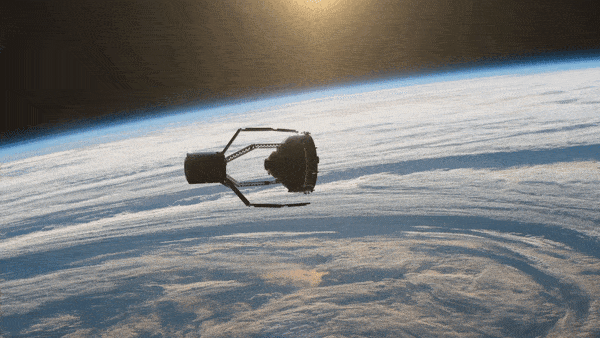
An ambitious space junk cleanup mission now has its rocket ride.
Swiss startup ClearSpace plans to launch an "active debris removal mission" to take out a piece of space junk no earlier than the first half of 2026. That mission, known as ClearSpace-1, will ride aboard an Arianespace Vega-C rocket, we learned on Tuesday (May 9).
ClearSpace-1 aims to "rendezvous, capture and remove a piece of space debris," according to a press release issued Tuesday by France-based Arianespace.
If all goes to plan on the mission, which is funded by the European Space Agency (ESA), the ClearSpace-1 spacecraft will meet up with a payload adapter left behind by a Vega rocket launch in 2013. The adapter is already in a "gradual disposal" orbit, meaning that it will fall back into Earth's atmosphere naturally without intervention.
"The simple shape of this space debris will allow [the mission] to demonstrate the technologies of the spacecraft and its quartet of robotic arms, thus opening the way for more challenging missions with multiple captures per flight," Arianespace added in Tuesday's statement.
Related: The worst space debris events of all time
Since the space age dawned in 1957, humans have sent more than 12,000 satellites to space, according to ESA. While most of them are active or have naturally entered Earth's atmosphere, ESA estimates there are 3,000 non-operational spacecraft still in orbit.
Hundreds more satellites launch every year. Many of them are part of SpaceX's Starlink megaconstellation, which aims to have 40,000 members in orbit eventually, tenfold the 4,000 currently active Starlink craft.
Then there are the pieces left behind by space missions. ESA estimates that Earth orbit has about 36,500 debris objects more than 4 inches (10 centimeters) wide, 1 million between 0.4 inches and 4 inches (1 to 10 cm) across, and 330 million that are smaller than 0.4 inches (1 cm) but bigger than 0.04 inches (1 millimeter).
Each of these pieces whips around the Earth at incredible speed. For example, the International Space Station (which has had to dodge orbital debris dozens of times) is in an orbit where objects fly at about 17,100 mph (27,500 kph). With more spacecraft and pieces comes more risk of debris crashing into each other, or even slamming into active spacecraft, which does happen occasionally despite operators' best efforts.
Related: How often does the International Space Station have to dodge space debris?
The Vega-C rocket has made two flights to space to date. Its first flight, in July 2022, was a success, but the second, which launched on Dec. 20, failed due to a fault in a rocket nozzle, according to an investigation cited by ESA in March.
Arianespace has pledged to implement the recommendations of the investigation commission and target another launch of Vega-C in late 2023.
Vega-C is a more powerful successor to the Vega set of rocket lines that debuted in 2012. Vega-C can send 5,070 pounds (2,300 kilograms) of payload to a 435-mile-high (700 kilometers) sun-synchronous orbit, compared to 3,300 pounds (1,500 kg) for the older rocket, according to Arianespace.
Another mission with ESA funding, by Tokyo-based Astroscale's ELSA-d, launched in March 2021 with a simulated piece of debris. Debris-capture tests were halted in May 2022, however, due to "anomalous spacecraft conditions," Astroscale said at the time.
Elizabeth Howell is the co-author of "Why Am I Taller?" (ECW Press, 2022; with Canadian astronaut Dave Williams), a book about space medicine. Follow her on Twitter @howellspace. Follow us on Twitter @Spacedotcom or Facebook.







